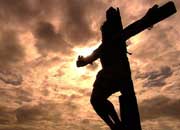Jesus frequently
referred to himself as a prophet and behaved as one. He frequently prophesized,
performed miracles similar to that of Old Testament prophets, gave prophetic
parables, and performed actions that can only be described as enacted parables.
Actions such as withering a fig tree, raising the dead, and cleansing the
Temple were not just acts of power meant to impress the disciples but pointed
towards a higher truth of God’s immediate actions in the world right then and
there in Jesus’ ministry.
The main thrust of
his prophetic mission, as he understood it, was to enact Yahweh coming to Zion,
God returning to his people, the Lord bringing his people out of Exile by the
forgiveness of sins. At the same time, Jesus giving the prophetic warning that
if the people refused to believe in him (i.e., follow his way of being the
people of God) then God would allow the Romans to destroy them (see Matthew
24-25; Luke 21:10-38; Revelation 4-19). God was fulfilling his promises in
Jesus but the people were missing it.
So when we come to
Jesus’ Feeding of the 5000 people (Matthew 14:13-21; Mark 6:30-44; Luke
9:10-17; John 6:1-14) we can assuredly expect that Jesus is not just feeding
people and not simply exhibiting his power to impress the disciples.
For the past few
month the Children’s Ministry has been covering many of the miracles of Jesus
and explaining to the kids how they show Jesus’ power over creation and how God
was supporting Jesus’ ministry. That, of course, is all true and its good milk
that tastes like meat for the spiritually young. However, there is, as I’ve
suggested, more to Jesus’ action that to build excitement among the faithful.
John, in his
Gospel, does the best job of interpreting Jesus’ actions by having him explain
in his version that he is “the bread of life” (John 6:35, 48). He further
states that “Moses gave you not that bread from heaven; but my Father
gives you the true bread from heaven. For the bread of God is he which comes
down from heaven, and gives life unto the world” (John 6:32-33). John is
writing his Gospel long after the destruction of Jerusalem and the Temple in 70
CE but he still maintains the connection to Moses in the wilderness.
When we turn back to a less “spiritual” account as found in the
Synoptic Gospels, we are still drawn to the comparison of Moses and the Israelites
in the wilderness. Jesus has been reconstituting Israel around himself by
appointing 12 disciples (12 tribes of Israel), giving new commandments ala
Moses (the Sermon on the Mount), and eventually holding a new Passover meal
(the Last Supper). In feeding the 5000, Jesus assumes another role of Moses:
providing the manna from heaven.
For Jesus’ contemporaries, these actions pointed to the idea of Exodus
from captivity. The Jews of Jesus’ day still believed that they were in
spiritual exile due to their sins and they were waiting for a spiritual exodus
when God would return to his people and release them. In enacting these
parables, Jesus was associating himself with Moses and declaring that he was
the promised deliver, here to bring the people out of captivity.
The prophetic act of feeding 5000 people was not simply an act of
wonder performed to amaze the crowds like a magician pulling a rabbit out of
his hat. This was a pointed declaration that Jesus was a great prophet, a new
Moses, sent by God to deliver his people out of their spiritual captivity.
 "Thinking Eternally, Acting Locally." - Neal August
"Thinking Eternally, Acting Locally." - Neal August
No comments:
Post a Comment